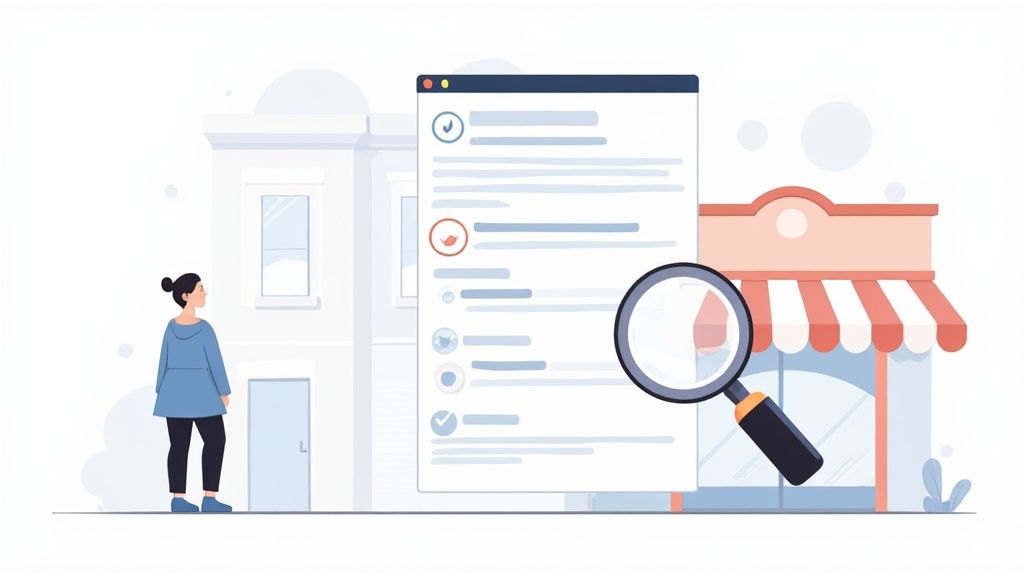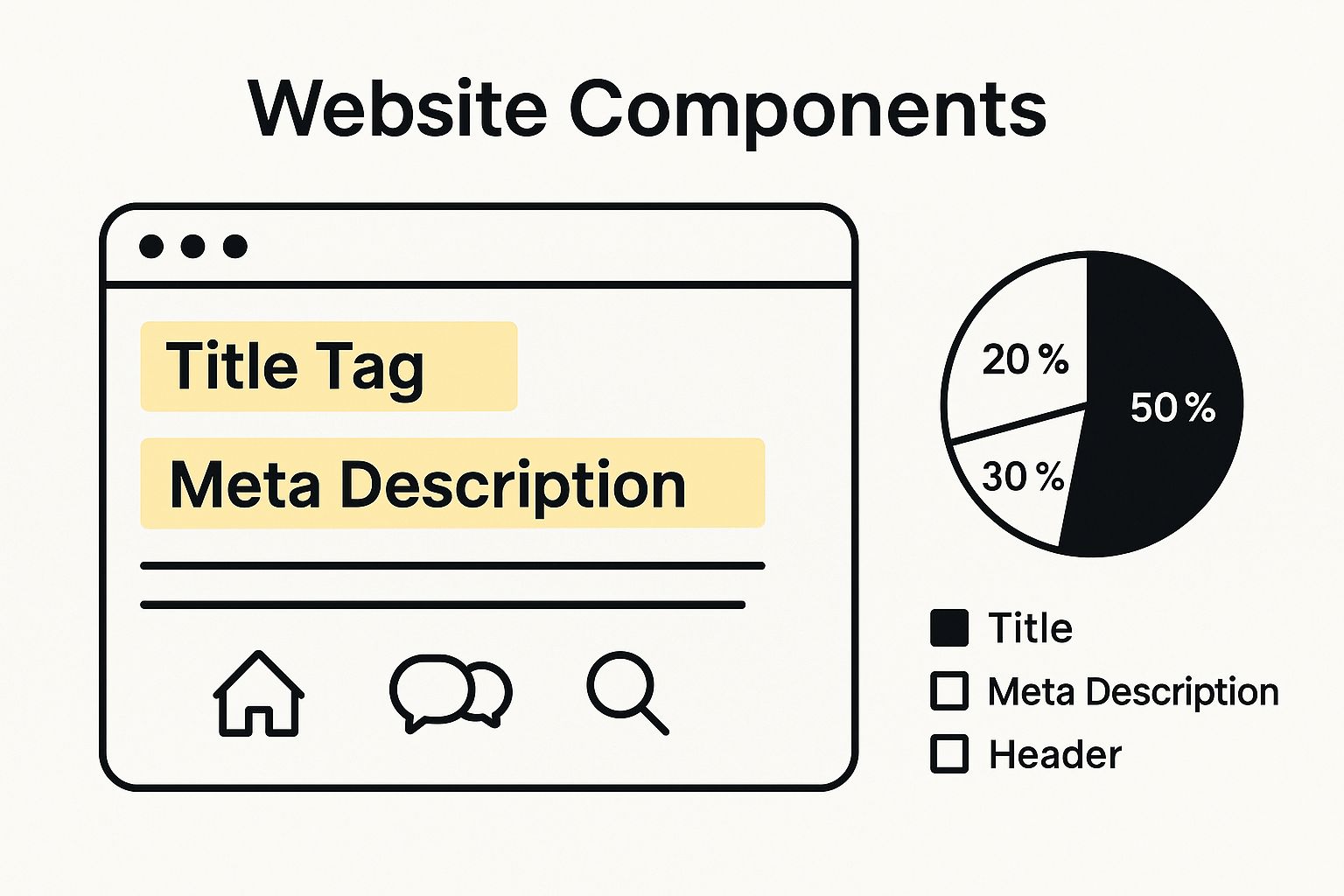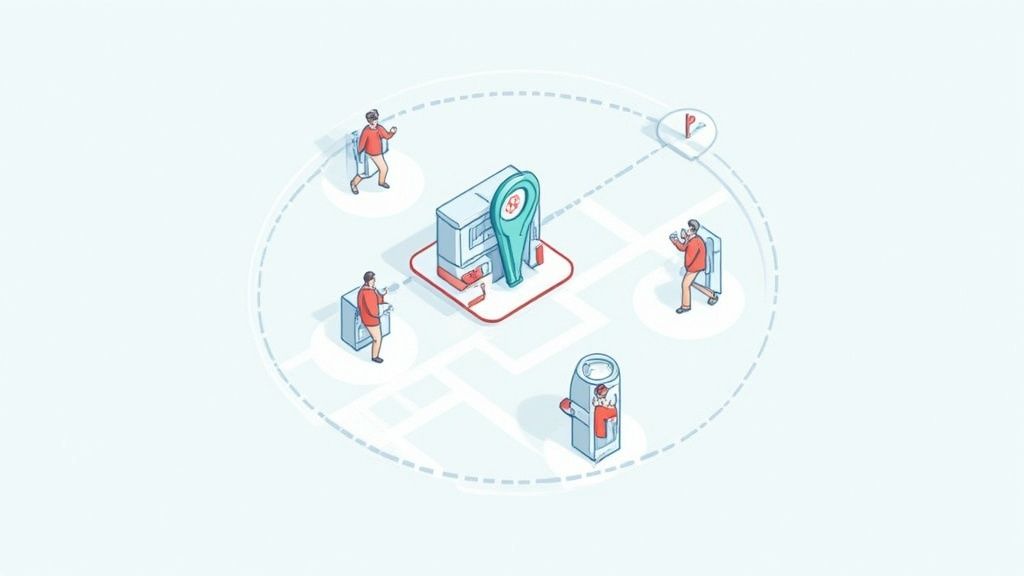
SEO for Small Business: Proven Strategies to Boost Rankings
Sections
- Why Small Business SEO Isn't Just Nice to Have - It's Your Lifeline
- Finding Keywords That Actually Bring Paying Customers
- Website Optimization That Won't Break Your Budget
- Mastering Local SEO to Own Your Market
- Creating Content That Ranks High and Converts Visitors
- Building Authority Through Strategic Link Building
- Measuring What Matters and Optimizing for Growth
#Why Small Business SEO Isn’t Just Nice to Have - It’s Your Lifeline

Let’s be real: as a small business owner, you’re already juggling a dozen other jobs. The thought of adding “search engine optimization” to your plate can feel like one task too many. It’s easy to push SEO to the bottom of the list, labeling it a “nice-to-have” for someday when you have more time or a bigger budget. But that way of thinking could be one of the most expensive mistakes you make. SEO for small business isn’t a luxury—it’s the engine that drives modern customer growth.
Picture two local bakeries in the same town. One relies on people walking by and word-of-mouth recommendations. The other took the time to set up their SEO. When a newcomer searches “best cupcakes near me,” the optimized bakery pops up first on Google, complete with great reviews and a link to their website. The first bakery? It might as well not exist online. This isn’t just a story; it’s what happens every single day. If you ignore SEO, you’re essentially handing customers over to your competition.
#The Real Cost of Being Invisible
The price of doing nothing is much higher than the investment in a smart SEO plan. Every day your business isn’t showing up in search results is a day you’re missing out on sales. While you’re standing still, your competitors are grabbing the market share you’ve left behind. They are ranking for the exact keywords your ideal customers use, building trust, and becoming the go-to experts in your field.
This isn’t just a hunch; the numbers back it up. The global SEO industry was valued at roughly $82.3 billion in 2023 and is expected to grow dramatically. This explosion shows just how vital search visibility has become for every type of business. You can read more about the expanding global SEO market from Exploding Topics to see the full picture.
#The Immediate Impact of Committing to SEO
So, what really happens when a small business finally decides to focus on SEO? Everything changes. You stop waiting for customers to stumble upon you and start actively meeting them where they’re already looking. A good strategy brings a consistent flow of qualified leads—people actively searching for the exact things you sell.
This shifts your business from being a passive bystander to an active player in your own success story. Here’s what you can look forward to:
- Increased Credibility and Trust: Showing up high on Google sends a powerful signal to customers that you’re a legitimate, well-regarded business.
- A Competitive Edge: Smart SEO allows you to compete with, and even beat, larger companies in your local market.
- Measurable Returns: Unlike a billboard or a radio ad, SEO provides data you can track. You can see how many people visit your site, what they’re looking for, and how they become paying customers.
- Sustainable Growth: Once you earn strong rankings, you get consistent, organic traffic that doesn’t just stop when you turn off an ad campaign.
Putting off a proper SEO for small business strategy for another few months isn’t just a delay—it’s a direct loss of income and an open invitation for your competitors to get ahead. It’s time to stop being invisible and start claiming your territory online.
#Finding Keywords That Actually Bring Paying Customers
Effective SEO for a small business comes down to one crucial thing: finding the right keywords. This isn’t about chasing the broadest, most popular terms. It’s about discovering the exact phrases your ideal customers type into Google when they’re ready to open their wallets. Too many businesses get this wrong, focusing on high-volume keywords that only attract window shoppers instead of serious buyers. The secret is to think less like a marketer and more like your customer.
Imagine you own a custom woodworking shop in Denver. Targeting a generic keyword like “wood furniture” puts you in a global competition you simply can’t win. It’s far too broad. The person searching might be a student doing homework or a hobbyist just looking for ideas. A customer who is ready to buy, however, is much more specific. They’ll search for things like “custom dining room table Denver” or “reclaimed wood bookshelf Colorado Springs.” These are called long-tail keywords, and they are a goldmine for small businesses. While they have lower search volume, they carry much higher buyer intent.
#Digging for Gold: Uncovering Buyer-Intent Keywords
So, how do you find these valuable, specific phrases? You start by listening to the people who already pay you.
- Talk to your customers: What words did they use when they first called or walked in? Jot down the exact phrases they used to describe their problem or what they needed.
- Analyze your contact forms: Look at the language people use when they email you. Are they asking for “help with,” a “quote for,” or “prices on” a specific service? These are pure gold.
- Use free tools smartly: Google’s own search bar is your best friend. Start typing a service you offer, like “local plumber services,” and see what Google suggests in the autocomplete dropdown. These are real searches people are making right now. The “People also ask” section on the search results page is another treasure trove of customer questions you can answer on your site.
The goal is to build a list of keywords that show someone is moving from just researching to actually buying. A search for “how to fix a leaky faucet” is informational. But a search for “emergency plumber near me” is transactional—that person needs help, and they need it now. Focusing on the latter is how a small business drives immediate business.
This simple infographic shows just how critical it is to get your title tag and meta description right. They are your first impression in the search results and your chance to stand out.

This visual highlights that your title and description act as your sales pitch in the search results, making it the perfect place to include those powerful buyer-intent keywords you’ve found.
#Comparing Keyword Research Tools for Small Budgets
While big agencies have access to expensive software, you can get fantastic results with free or low-cost tools. The key is knowing which one to use for what task. Don’t feel pressured into a pricey subscription right away; many free versions offer more than enough power to get started. If you want to dive deeper into this topic, you can also explore how to optimize your site for a wider range of queries by checking out our guide on the magic of keywords.
To help you choose, here’s a practical breakdown of some popular options that won’t break the bank.
#Keyword Research Tools Comparison for Small Businesses
Compare free and affordable keyword research tools with their features, limitations, and best use cases for small businesses
| Tool Name | Cost | Best Features | Limitations | Ideal For |
|---|---|---|---|---|
| Google Keyword Planner | Free (with Google Ads account) | Provides search volume data directly from Google; good for local targeting. | Data is often grouped into wide ranges; designed more for paid ads. | Validating keyword ideas and getting baseline traffic estimates. |
| AnswerThePublic | Freemium | Visualizes questions, prepositions, and comparisons related to your keyword. | Free version has daily search limits; doesn’t show search volume. | Finding blog post ideas and understanding customer questions. |
| Ubersuggest | Freemium | Shows keyword difficulty, top-ranking pages, and content ideas. | Free searches are limited; advanced features require a paid plan. | All-in-one research for beginners who need keyword and competitor insights. |
Ultimately, a successful keyword strategy for a small business isn’t about having the most expensive tools; it’s about having the smartest approach. By focusing on keywords with clear buyer intent and using affordable tools to confirm your ideas, you can attract customers who aren’t just browsing, but are actively looking to spend money. This targeted method saves you time and ensures your marketing efforts translate directly into business growth.
#Website Optimization That Won’t Break Your Budget
It’s a common myth that good SEO means hiring expensive developers for a complete website overhaul. Honestly, some of the most effective optimizations are surprisingly simple and won’t cost you a fortune. A solid SEO for small business strategy often starts with improving what you already have, not building from scratch. Think of it like a car tune-up; sometimes, just cleaning the spark plugs and changing the oil can make it run dramatically better.
Many small business sites are held back by basic technical issues that are surprisingly easy to fix. We’re not talking about complex coding problems, but small friction points that hurt both the user experience and your search rankings. Before you even think about advanced tactics, focusing on these fundamentals can deliver the biggest improvements with the least amount of effort.
#Check Your Speed and Mobile Experience First
Two of the biggest roadblocks for small businesses are slow loading times and a clunky mobile experience. Google gives a thumbs-up to websites that are fast and easy to use on a smartphone because, let’s face it, that’s how most people browse these days. A mere one-second delay in mobile load times can slash conversion rates by up to 20%. That’s a huge loss of potential customers just because your site is too slow.
You don’t have to guess if your site has a speed problem. Google offers a free tool called PageSpeed Insights that will analyze your website and give you a clear report card.
Here’s an example of what the PageSpeed Insights dashboard looks like, showing performance scores for both mobile and desktop.
 The report points out specific issues, like oversized images or clunky code, and even gives you suggestions on how to fix them.
The report points out specific issues, like oversized images or clunky code, and even gives you suggestions on how to fix them.
Fixing these problems often boils down to a few practical actions:
- Compress Your Images: Large, unoptimized images are the number one cause of slow websites. Before you upload any photo, run it through a free online tool like TinyPNG. It shrinks the file size without making your photos look grainy. This one change can make a massive difference.
- Check Mobile Friendliness: Just pull up your website on your phone. Can you easily read the text without pinching and zooming? Are the buttons simple to tap? If not, your site isn’t mobile-friendly. Most modern website builders (like Squarespace or Wix) handle this automatically, but if your site is older, this is a crucial fix.
#Fine-Tuning Your On-Page Elements
Once your site is fast and works well on mobile, the next job is to make sure each page clearly tells Google what it’s about. This is where on-page optimization comes into play. It’s all about organizing your content so search engines can easily understand it. You don’t need to be an expert to make meaningful changes. A great place to start is with your page titles, headings, and URLs.
For instance, instead of a generic page title like “Services,” try something more specific like “Residential Plumbing Services in Austin, TX.” This instantly tells both Google and potential customers exactly what you do. Similarly, use headings (H2s and H3s) to break up your text and highlight important topics on the page.
If you want a full rundown of all the elements you should check, our detailed on-page SEO checklist is a great resource. It gives you a straightforward framework for auditing your own pages. These small tweaks help Google connect your content to the right searches, bringing in better traffic without you spending a dime on developers.
#Mastering Local SEO to Own Your Market
While tackling global SEO can feel like you’re up against giants, local SEO is where small businesses truly shine. For a neighborhood cafe, a local plumber, or a boutique shop, winning the search battle for customers just around the corner is infinitely more valuable than ranking for a broad, national term. This is the heart of a smart SEO for small business strategy: completely owning your immediate service area. When you get this right, you’re not just another name in a list; you become the go-to choice for nearby customers who are ready to make a purchase.
The impact of getting local search right is huge. Just think about this: recent data shows that a whopping 78% of local searches on a mobile device lead to an offline purchase within 24 hours. This isn’t just about driving website traffic; it’s about getting real, paying customers through your door—and quickly. Appearing in Google’s coveted “Local Pack” (that map with three listings at the top of the search results) can be a massive win. Businesses featured there often enjoy a 40% higher click-through rate compared to their competitors further down the page. To see more data on this, you can check out some great insights on small business SEO at Page Optimizer Pro. This isn’t a minor advantage; it’s a fundamental shift in how you find new customers.
The numbers below paint a clear picture of just how powerful local SEO can be for a small business’s bottom line.
| Local SEO Impact Statistics | |||
|---|---|---|---|
| Metric | Percentage | Impact | Timeframe |
| Local Mobile Searches Leading to a Purchase | 78% | Directly drives in-store sales | Within 24 hours |
| Click-Through Rate (CTR) Increase in Local Pack | 40% | Significantly more website and profile clicks | Ongoing |
| Searches Containing “Near Me” | 200%+ | Shows growing hyper-local customer intent | Over the last two years |
| Local Searches Resulting in a Store Visit | 50% | Converts online interest into foot traffic | Within one day |
As you can see, optimizing for local search isn’t just a “nice-to-have.” It’s a direct line to the customers in your community who are actively looking for the services you offer.
#Your Google Business Profile: The Cornerstone of Local SEO
Think of your Google Business Profile (GBP) as the most critical tool in your local SEO kit. It’s not just a simple listing; it’s your digital storefront on Google Search and Maps. The problem is, too many businesses fill it out once and then forget about it, leaving so much opportunity on the table.
Making your GBP a customer magnet is an ongoing effort, not a one-time task. Here’s how you can make it work harder for your business:
- Fill Out Every Single Section: Don’t leave any field blank. Add your business hours, list all your services, and include specific attributes like “free Wi-Fi” or “wheelchair accessible.” In your description, be specific. Instead of just “bakery,” try “Artisan sourdough bakery in downtown Austin specializing in organic pastries and locally roasted coffee.”
- Use Google Posts Weekly: These are like free mini-advertisements right on your profile. Share updates about special offers, new products, or community events. A quick post about a “2-for-1 espresso deal this Friday” not only informs potential customers but also signals to Google that your business is active and relevant.
- Actively Manage Your Reviews: Customer reviews are a huge factor in local rankings. Make it a habit to respond to all feedback, both positive and negative. A thoughtful, professional response to a bad review can often do more to win over future customers than a dozen five-star ratings because it shows you genuinely care.
- Upload High-Quality Photos and Videos: People want to see what you’re about. Regularly add new, high-quality photos of your storefront, your products, your team, and happy customers. A pro tip is to geo-tag your images with your location’s coordinates before uploading them; it can give you a small but valuable SEO nudge.
#Building Local Authority Beyond Google
While your GBP is the foundation, true local dominance comes from sending consistent signals across the web that reinforce who you are and where you are.
A crucial part of this is building local citations. A citation is any online mention of your business’s Name, Address, and Phone number (NAP). The key here is consistency. Your NAP must be absolutely identical everywhere it appears, from your Yelp profile and local chamber of commerce directory to niche industry sites. Even small inconsistencies can confuse search engines and weaken your local authority.
Another effective tactic is creating content specifically for your location. If you’re a roofer in Chicago, don’t just write a generic post about “roofing tips.” Instead, create articles like “Preparing Your Roof for a Brutal Chicago Winter” or “Common Roofing Issues in the Lincoln Park Neighborhood.” This kind of hyperlocal content directly answers local search queries and establishes you as the expert for that specific area. By focusing on these strategies, you build a strong, defensible presence in your local market that larger, more generic competitors simply can’t match. By the way, if you ever find yourself needing to move your website to a new address, remember that careful planning is key to keeping your hard-earned rankings. We’ve put together a helpful guide on handling the SEO for a domain migration that you might find useful.
#Creating Content That Ranks High and Converts Visitors
Creating powerful content doesn’t mean you need to chain yourself to a keyboard and pump out daily blog posts. For a small business, a winning content plan is all about quality and purpose, not just volume. The best content pulls double duty: it directly answers the questions your customers are asking, and it shows search engines like Google that you’re an expert in your field. This mix of being genuinely helpful and knowledgeable is how you create content that not only ranks well but also turns casual visitors into loyal customers.
Many business owners see blogging as just another task on a long to-do list, but it’s one of the most effective tools in your SEO for small business kit. Every well-crafted post is another chance for your business to get discovered. Think of each article as a permanent digital employee that works for you 24/7, attracting potential customers long after you’ve hit “publish.”
#Quality Over Quantity: The Small Business Advantage
You don’t have to publish content every single day to get real results. In fact, one deeply researched, helpful article is far more valuable than ten short, generic posts. A local landscaping company, for example, will get much more attention from a single, detailed guide on “The Best Drought-Resistant Plants for Texas Summers” than from ten quick posts about “mowing tips.” Why? Because that detailed guide solves a specific, urgent problem for their target audience and positions them as the local authority.
This strategy is about creating cornerstone content—these are the substantial, informative pieces that your customers will find incredibly useful. These posts do more than just attract organic traffic; they build trust, which is crucial for turning a visitor into a customer. When someone sees that you’ve invested the time to thoroughly answer their questions, they’re far more likely to choose your business when they’re ready to make a purchase.
#Efficient Content Creation for Busy Schedules
Being short on time doesn’t mean your content marketing has to suffer. The secret is to work smarter, not harder. One of the most powerful strategies to accomplish this is content repurposing. That single, in-depth blog post can easily become the fuel for an entire week’s worth of marketing materials.
Here’s what that looks like in a real-world scenario:
- The Core Piece: You write a 1,500-word blog post titled “A Homeowner’s Guide to Preparing for a Kitchen Remodel.”
- Social Media Posts: Pull five key tips from the article and turn them into individual graphics for Instagram and Facebook.
- Email Newsletter: Summarize the main points in your monthly newsletter, adding a strong call to action that encourages subscribers to read the full article on your blog.
- Short-Form Video: Film a 60-second video for TikTok or Instagram Reels where you quickly walk through the “Top 3 Mistakes to Avoid in a Kitchen Remodel,” all based on your original post.
- FAQ Page: Use the questions your article answers to build out a new FAQ page on your website, which can help you show up for very specific, long-tail keyword searches.
This approach lets you squeeze every drop of value from the content you create, reaching different parts of your audience on various platforms without starting from scratch every time. It’s a practical way to keep an active online presence and continuously reinforce your expertise. A smart content plan for a small business is all about creating truly valuable, problem-solving resources and then cleverly distributing them to get the most impact from every minute you invest.
#Building Authority Through Strategic Link Building
If you’ve spent any time looking into SEO, you’ve probably come across the term “backlinks.” A backlink is simply a link from another website to yours. Think of it as a vote of confidence. When a well-regarded website links to you, it’s telling Google that you’re a credible source of information. This is a massive part of building your website’s authority, a core element of any solid SEO for small business strategy.
Many business owners hear “link building” and immediately think of pricey campaigns or those annoying, spammy outreach emails. For a small business, the best path is much more genuine and built on relationships. You already have a network in your community and industry; effective link building is about turning those real-world connections into online credibility. It’s about creating value that others naturally want to share.
#Earning Links Through Local and Industry Connections
Your most valuable link-building opportunities are often hiding in plain sight with the people and organizations you already interact with. The aim is to get high-quality, relevant links from trusted sources in your local area or industry niche.
Here’s how you can transform your existing relationships into powerful SEO assets:
- Local Partnerships: Do you sponsor a local kids’ soccer team or donate to a community food drive? Reach out and ask if they can add a link to your website on their “sponsors” or “supporters” page. These links are super relevant and signal to Google that your business is an active part of the community. For instance, a local coffee shop could team up with a nearby bookstore for a joint event and get a link from the bookstore’s event page.
- Industry Suppliers and Distributors: Consider the businesses you purchase from. If you’re a restaurant that proudly features produce from a specific local farm, ask if that farm would be willing to mention you on their “partners” page with a link back to your website. It’s a natural endorsement that makes sense to both your customers and search engines.
- Host a Community Event or Workshop: Offering a free workshop, like a “DIY Home Repair Basics” class at a hardware store, creates a genuinely useful community resource. Local event calendars, community blogs, and even local news outlets are often happy to link to events like these, giving you fantastic local backlinks.
#Creating Link-Worthy Content
Beyond direct outreach, the other side of the link-building coin is creating content so helpful that other websites can’t help but reference it. This isn’t just about churning out blog posts; it’s about creating valuable resources.
A perfect example would be a local accounting firm creating a “Small Business Tax Deadline Calendar for Ohio.” This is a practical, valuable tool that local business publications, the Chamber of Commerce, and industry bloggers would gladly link to in their own articles. It solves a real problem for their audience and positions your business as the go-to expert. By focusing on these ethical, relationship-driven strategies, you build an online authority that is both powerful and lasting.
#Measuring What Matters and Optimizing for Growth
Hitting the first page of Google is a great feeling, but it’s not the finish line. In fact, that’s where the real work begins. True success in SEO for small business isn’t about bragging rights over a top keyword ranking; it’s about seeing real, measurable growth that affects your bottom line. If you’re not tracking your results, you’re basically driving with your eyes closed, hoping you’re headed in the right direction.
The great news is you don’t need a massive budget or a team of data scientists for this. Powerful and free tools like Google Search Console and Google Analytics provide all the information you need to make smart, data-backed decisions for your business.
#Ditching Vanity Metrics for Business-Driving KPIs
First things first, let’s separate what looks good from what actually is good for business. It’s easy to get excited about high traffic numbers, but if those visitors aren’t turning into customers, it’s just noise. We need to focus on Key Performance Indicators (KPIs) that tie directly to your revenue and customer growth.
Here are a few metrics that truly tell the story of your SEO success:
- Organic Traffic Conversion Rate: This is the big one. It shows you what percentage of your visitors from search engines are taking a meaningful action—like filling out your contact form, calling your shop, or buying a product. A healthy conversion rate is proof that your SEO is attracting the right audience.
- Cost Per Acquisition (CPA) from Organic Search: While you’re not paying per click, your time and effort are valuable. Calculating your organic CPA helps you understand the true return on your SEO investment and how it stacks up against other channels, like paid advertising.
- Keyword Performance by Conversions: Don’t just look at which keywords bring in eyeballs; see which ones bring in business. You might discover that a low-traffic, specific phrase like “emergency roof repair in Dallas” converts like crazy, while a broad term like “roofer” just brings in tire-kickers. This is gold—it tells you exactly where to aim your content strategy.
#Using Data to Refine and Adapt Your Strategy
Think of your analytics not just as a report card, but as a roadmap for what to do next. By regularly checking your performance data, you can spot small issues before they become big problems and uncover new opportunities you might have otherwise missed.
Let’s say you’re a local bakery. You check your analytics and see a blog post about “gluten-free wedding cakes” is getting a surprising amount of traffic, but its bounce rate is through the roof. The data is screaming at you: people are interested, but the page isn’t giving them what they need. This is a clear signal to beef up that page with more details, gorgeous photos, and an obvious call-to-action to book a tasting. By listening to the data, you can turn a missed chance into a fresh stream of qualified leads.
This cycle of measuring, analyzing, and optimizing is what creates sustainable growth. It turns SEO from a one-and-done task into a living part of your business that constantly adapts to what your customers want, ensuring your investment pays off for years to come.
Ready to dig deeper into your website’s performance and uncover hidden growth opportunities? Rankdigger’s powerful analytics tools can help you transform raw data into a clear action plan. Explore how Rankdigger can fuel your SEO growth today.

